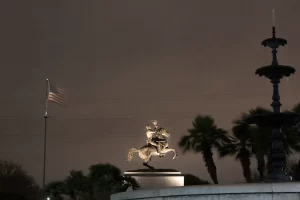Thomas Wolfe Memorial

The homes we spend our lives in become a part of us. They’re integral to the collective influences that mold and shape our personalities and values. Then, as our journey on this planet comes to an end, the roles shift, and we become a part of them. You could say that’s what happened between autobiographical author Thomas Wolfe and the home he grew up in, Asheville’s historic Old Kentucky Home.
The building’s history is extensive, but Wolfe and his family are the endcap of a legacy that began in the late 19th century. So closely tied to the unassuming property, Thomas Wolfe is said to call his former residence home still. Visitors may catch a glimpse of Wolfe’s coy apparition or spot another shadow lurking in the halls: the ethereal presence of Thomas’ mother, Julia.
The Thomas Wolfe Memorial welcomes all with its antiquated charm, but do its eternal residents care for visitors? Come and see for yourself as part of an Asheville ghost tour.
The Early Years of 48 Spruce Street
While the Wolfe family may have been the last to reside at what is now the Thomas Wolfe Memorial, the home’s history dates back to the late 19th century and a private banker named Erwin Sluder.
Sluder built the small seven-room Queen Anne-inspired home atop a 95 x 190-foot lot as a wedding gift to his daughter. However, within a year of its construction, Sluder the property sold to one J. H. Herring, who, in turn, sold the home back to Sluder’s daughter, Cordelia Barnard, just under a year after his purchase.
The house made another transfer in 1889 to Mrs. Alice Johnston Reynolds. Major improvements were made to the infrastructure, as Reynolds modernized it with power and water before opening it up as a boarding house. Unfortunately, Reynolds’ vision was short-lived, as she became the first of the property’s owners to pass away while still in possession.
Could Mrs. Reynolds be the female spirit said to haunt the memorial today? It is possible, but the home would be sold once more before landing in the hands of who would become the more likely source of one of haunted Asheville’s most known specters, Julia Wolfe.
The Wolfe Family Moves In & Tragedy Strikes
After Mrs. Reynold’s passing, a reverend and his wife, Thomas, and Mary Myers, kept the boarding house running under the moniker the “Old Kentucky Home.” For six years, they operated the lodging, eventually selling it to Julia, an aspiring businesswoman who lived nearby with her husband, William Oliver Wolfe.
By the time the Wolfe’s took possession of the boarding house and its 19 tenants, Julia had given birth to eight children, two of whom had previously passed. Young Leslie and Grover never saw the inside of the Old Kentucky Home, but Grover’s twin, Benjamin, had. The Wolfes owned the boarding home for years without significant incident and even expanded the property to allow for more tenants. Then the 1918 flu epidemic hit, claiming Ben, who passed away in the Spruce Street property.
Ben’s passing marked the home’s second potential spirit, a restless soul taken by nature’s wrath. Still, there remained another member of the Wolfe family who would go on to be the property’s namesake inhabitant: Thomas Clayton Wolfe.
Thomas Memorializes the Old Kentucky Home
Even early on in life, Thomas had the makings of a successful creative. After graduating from North State Fitting School, he enrolled at the University of North Carolina at Chapel Hill, where he joined the Dialectic Literary Society and wrote for the campus newspaper.
The young writer penned his first drama as a student and member of Frederick Koch’s Carolina Playmakers. The Return of Buck Gavin was the first of many works Thomas would write. Even while studying at Harvard University and eventually teaching English at Washington Square College in New York, Thomas continued to put ink to the page and write.
His most significant work came in 1929, when he published his first novel, Look Homeward, Angel: A Story of the Buried Life. On the surface, it seemed to be little more than a coming-of-age story. However, it’s more widely believed that the novel was autobiographical, and the central character, Eugene Gant, reflected himself.
Whatever the novel’s purpose, there’s one thing it could have never predicted — that at 37 years old, Thomas Wolfe would be diagnosed with tubercular meningitis and pass away. Though the youngest Wolfe had moved away from the Old Kentucky Home and died far from his former residence, the memories he had resurfaced with Look Homeward, Angel, a memoir of his life and those who were part of it.
The Eternal Residents of the Thomas Wolfe Memorial
There are at least two stand-out reasons Wolfe’s memorial is an important part of the Asheville ghost tour: Thomas and Julia Wolfie. The matriarch and her son reunited seven years after his death and still call the memorial home, even as curious guests roam about, seeking signs of the afterlife. Young Ben may even have joined his family, possibly as one of the ghosts seen in the home’s dining room.
The Wolfe family may have ties to the home, but it’s true that one other of the building’s former residents actually passed while close to home. Mrs. Alice Johnston Reynolds had a strong tie to the memorial, having put effort into making it the livable space the Wolfe family eventually moved into.
Of course, only one specter could be responsible for the faint clack of a typewriter often heard echoing down the hall. Having died so young, Thomas may be behind the sound, forever stuck in a loop of trying to finish his life’s work.
Visit the Specters of Asheville
Asheville’s roots date back to the 18th century when Colonel Samuel Davidson first settled the land after the American Revolution. Over that time, the city has amassed a paranormal presence that serves as the focal point of any Asheville ghost tour.
Visit Thomas Wolfe at his former home or visit the imposing, gothic architecture of the Basilica of St. Lawrence to explore some of the region’s most haunted locations. Want to have a little fun and loosen up for your intimate evening with the supernatural, consider one of our Boos and Booze Haunted Pub Crawls.
To find out more about Asheville’s local haunts and more of North Carolina’s most haunted locations, visit our blog and check out our socials on Facebook, Instagram, and TikTok. Don’t miss out on an unforgettable evening — book your Asheville Terrors tour.
Sources:
https://wolfememorial.com/history/the-house-1880s-1950s/
https://historicsites.nc.gov/all-sites/thomas-wolfe-memorial/history
https://wolfememorial.com/history/the-wolfe-family/
https://wolfememorial.com/history/toms-life/
https://thebluebanner.net/15998/arts-features/ashevilles-haunting-history-leaves-room-for-mystery/
https://www.exploreasheville.com/iconic-asheville/about-asheville/history/#:~:text=After%20the%20American%20Revolution%2C%20Colonel,become%20the%20city%20of%20Asheville.

